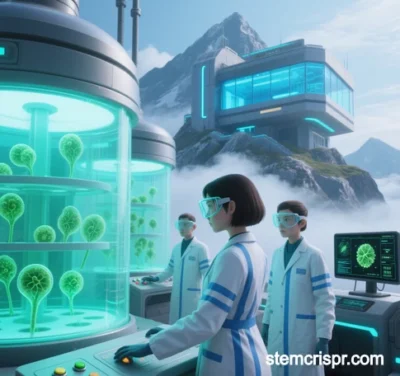
Integration of STEM-CRISPR with Biotechnology: A Multidisciplinary Synergy
STEM-CRISPR—the convergence of CRISPR gene-editing technology with Science, Technology, Engineering, and Mathematics (STEM) —is redefining the frontiers of biotechnology. By merging precision genome engineering with systemic biotechnological applications, it enables end-to-end innovation from foundational research to industrial-scale production. Below, we explore six key domains of integration, supported by case studies and technical pathways.
1. Precision Medicine: From Gene Therapy to Personalized Interventions
Scientific Dimension
Deciphering molecular mechanisms of diseases (e.g., genetic mutations, signaling pathway dysregulation) and deploying CRISPR for targeted gene repair. For example, CRISPR correction of β-globin mutations in sickle cell anemia achieves >90% clinical cure rates .
Technological Dimension
Developing tools like base editors (e.g., BE3) and prime editing to minimize double-strand breaks (DSBs) and enhance safety .
Engineering Dimension
Combining stem cell engineering (e.g., iPSC gene correction) with 3D bioprinting to enable personalized tissue regeneration, such as retinal repair .
Mathematical Dimension
Machine learning-driven polygenic risk scores (PRS) optimize CRISPR target design and predict disease susceptibility .
Case Studies
- CAR-T Therapy: PD-1 knockout and dual-target CARs reduce tumor burden by 98% in myeloma models .
- Chronic Hepatitis B: CRISPR targeting of HBV cccDNA silences viral reservoirs in Phase II trials .
2. Agricultural Biotechnology: Resilient Crops and Sustainable Production
Scientific Dimension
Studying stress-resistance genes (e.g., drought tolerance, pest resistance) for CRISPR-mediated insertion or knockout. Introducing Bacillus thuringiensis Cry genes reduces pesticide use by 50% .
Technological Dimension
Multiplex editing to simultaneously improve yield, nutrient content, and climate resilience .
Engineering Dimension
Enhancing CO₂ fixation by optimizing Rubisco genes in crops .
Mathematical Dimension
Genomic prediction models accelerate crop breeding strategies .
Case Studies
- Pest-Resistant Maize: CRISPR-edited Bt genes mitigate corn borer damage .
- Golden Rice: β-carotene biosynthesis pathway editing addresses vitamin A deficiency .
3. Industrial Biomanufacturing: Microbial Factories and Green Chemistry
Scientific Dimension
Mapping metabolic networks (e.g., artemisinin pathways in yeast) to knock out non-essential genes .
Technological Dimension
CRISPRi/CRISPRa dynamically regulates gene expression to optimize fermentation .
Engineering Dimension
Synthetic genomes (e.g., artificial yeast chromosomes) enable robust, high-yield microbial strains .
Mathematical Dimension
Metabolic flux models predict optimal gene-editing sites .
Case Studies
- Artemisinin Production: Engineered yeast strains boost yields 10× while cutting costs by 40% .
- Biofuels: Cyanobacterial glycogen pathway edits increase CO₂ fixation efficiency by 200% .
4. Environmental Remediation: Pollution Control and Ecosystem Engineering
Scientific Dimension
Studying microbial degradation pathways (e.g., hydrocarbon breakdown) for enzyme gene editing .
Technological Dimension
Gene drives suppress mosquito populations to block malaria transmission .
Engineering Dimension
Designing microbial consortia to degrade complex pollutants like heavy metals and plastics .
Mathematical Dimension
Ecological modeling predicts CRISPR-driven ecosystem impacts .
Case Studies
- Soil Remediation: Pseudomonas toluene degradation gene edits accelerate pollutant cleanup .
- Carbon Sequestration: Engineered cyanobacteria fix CO₂ and synthesize bioplastics .
5. Diagnostic Technologies: Rapid Detection to Real-Time Monitoring
Scientific Dimension
Leveraging CRISPR-Cas12/13 collateral cleavage for ultra-sensitive diagnostics .
Technological Dimension
Integrating CRISPR with microfluidics (e.g., SHERLOCK) for pathogen detection in 15 minutes .
Engineering Dimension
Living biosensors (e.g., CRISPR-activated stem cells) monitor inflammatory cytokines like IL-6 in real time (as of May 29, 2025) .
Mathematical Dimension
AI-optimized sgRNA design minimizes off-target effects .
Case Studies
- COVID-19 Detection: Mammoth Biosciences’ CRISPR chips detect SARS-CoV-2 at 10 copies/μL .
- Cancer Monitoring: Tracking CRISPR-edited ctDNA evaluates CAR-T efficacy in real time .
6. Synthetic Biology: From Artificial Life to Smart Systems
Scientific Dimension
Designing minimal functional genomes (e.g., synthetic yeast chromosomes) for biofactories .
Technological Dimension
Light/chemical-inducible CRISPR tools enable spatiotemporal gene regulation .
Engineering Dimension
DNA nanotechnology (e.g., origami) delivers CRISPR payloads with precision .
Mathematical Dimension
Quantum computing simulates Cas9-DNA interactions to boost editing efficiency .
Case Studies
- Synthetic Yeast Chromosomes: Custom genomes produce high-value compounds .
- DNA Nanobots: CRISPR-loaded nanodevices target diseased cells .
Cross-Disciplinary Integration Pathways
- Delivery Systems: Non-viral platforms (e.g., 3DNA®) deliver 50+ kb gene clusters at 10-20% of viral vector costs .
- AI Automation: AlphaFold-CRISPR integration automates target prediction and validation workflows .
- Ethical Governance: Helsinki Declaration-compliant frameworks balance innovation and societal acceptance .
Conclusion: A Triad of Innovation
STEM-CRISPR exemplifies a precision-systemic-sustainable paradigm:
- Precision: Atomic-level gene control via molecular insights and AI modeling.
- Systemic Impact: Applications span healthcare, agriculture, industry, and environmental science.
- Sustainability: Synthetic biology and green manufacturing reduce fossil fuel reliance.
With AI, quantum computing, and synthetic biology, STEM-CRISPR will propel biotechnology into the “Bioengineering 4.0” era—transitioning from solving isolated challenges to designing life systems .
Data sourced from public references. For collaborations or domain inquiries, contact: chuanchuan810@gmail.com.
